|
At the end of the 2019 season I wrote a blog post called The 2019 WNY Season in Review: Records Broken. I went back to that post and pulled a quote. Here is the quote: "The 2019 season has crushed wind records since I began recording in 2011". Well, those records have once again been crushed. It's almost not believable that 2020 could be so good. We live in WNY, not Maui, not OBX, not the Gorge. 2020 was an incredible year in many, many ways! As a lot of you know I maintain a log to record all wind sessions when the wind blows at least 15-20mph for at least one hour and with air temps at least 40 degrees. You can learn more about this at WNY Wind Report and Wind Report Accuracy if you are interested. The last few years I also sorted the data to show sessions with air temps over 50 degrees and 60 degrees. By doing this it allows us to compare seasons in a more meaningful way than just relying on our memory of past years. Science continually proves that our memories are quite poor when it comes to comparing records from one year to another. But when we write it down we can use it to learn. For example, we can learn what sail/kite sizes are used most often during certain parts of the year. We can learn if bigger wind comes more with colder or warmer air temps. We can see if we are getting longer sessions during cold days or warm days. We think many of these observations are obvious, but very often the data shows that our "obvious thoughts" are completely wrong because our memory fails us. We may score a couple more sessions in December, but let's get into the data through the end of November. For 2020 we scored 198 sessions in the WNY area with average windsurfing sail size 4.9m. (Note, this data does NOT include windfoil data, only regular windsurfing) This translates into 5.2 windsurfing sessions per week on a 4.9m sail. Compare this to 2019, which gave us 159 sessions on average sail 5.0m and 4.5 sessions per week. It's simply AMAZING! The chart below summarizes the numbers: Even if you only ride when it's 60 degrees or warmer there were 117 sessions on average sail size 5.1m. Or if you ride when it's 50 degrees or warmer there were 143 sessions on average sail size 5.0m. Incredible! An interesting point to note is that, although there are fewer sessions on warmer days, sail sizes are not much larger on warmer days. See the charts below: When I sorted the data even further, I found that there were 30 sessions on 3.1m average sail size, and 90 sessions on 3.7m average sail size. Remember, this does NOT include foiling, only regular windsurfing. Holy moly! Is this the new Hatteras? 90 sessions on average sail size 3.7m for regular windsurfing??? Hard to believe. Many windsurfers don't even get a total of 90 sessions for the entire season on any sail size in a typical year, let alone size 3.7m. This season I personally sacrificed a lot of bigger-wind windsurfing sessions while in search of lighter wind to learn windsurf wave foiling (WWF). What an awesome adventure!!! If you have been considering WWF or windfoiling, but have not yet made the commitment, do it now! Lisa and I watched others windfoil for 5 years. Thank you to all those people who sorted out all the problems and challenges. The sport is now very streamlined, and your diligence is appreciated! For the rest of you, you don't need to wait any longer. The gear is now fantastic, and the sport is much easier to learn than it was just a couple years back. The biggest sail I use is now 4.7m. That allows me to foil in about 15mph wind, while regular windsurfers are all on 8.5m sails. And when the wind gets to 25mph I can jump on my 85 liter windsurfing board with the same 4.7m sail and have a blast on that. This season I got 65 sessions foiling with average sail size 4.0m. Twenty of those sessions were on average sail size 3.0m. And this was all while actively searching for lighter wind on many days. That's just incredible! Small sails are an everyday thing. They are so maneuverable, so fun, so lightweight! And the wave riding is unreal on the foil. Wave riding is the main reason that Lisa and I got foils, and it is even more fun than we expected. Windsurf wave foiling in 20mph is as much fun as regular windsurfing on waves in 35mph wind. The learning curve can seem intimidating at first, but progress will come much faster than you think. I took a windfoil lesson in Florida last February, and I remember saying to one of the instructors on day one that it felt like I was starting over. He said, "No, you will learn this much faster than when you started windsurfing." He was absolutely right. By the second session it was easy to get on foil, and after 5 sessions I was on foil all the time. Here is a little video footage of what you can expect after 50 sessions: If you decide to pursue WWF, or any kind of windfoiling, make sure you get the right gear. Large foil wings are one of the keys to having fun right from the beginning and learning quickly. A wide board with adequate volume is important for uphauling and efficiency. And, proper bottom shape is important for easy planing. Use your regular wave sails, but rig them very open. Bag out the sail so that it's right on the boom. Keep your boom a little lower as your knees will be very bent on the waves. Get into it! Do it now! It's THAT much fun! In this video I explain more about WWF: Regular windsurfing was even more INCREDIBLE than ever this year because the sessions were bigger! This season my average sail size for regular windsurfing was 4.1m. There were so many sessions with wind over 40mph this season while the air was still WARM. No mittens or gloves required. In other years, we didn't get big wind unless the air temp was quite chilly. Amazing waves on 2.9m sails during many windsurfing sessions this year. The stoke was INTENSE! Windsurfing and WWF go so well together. I scored over 100 total sessions this season and have just 2 boards in my entire quiver....an 85 liter freewave board and 120 liter WWF board. I have just six sails total, and one boom. This small quiver allows me to ride in wind from 15mph to 50mph. (You may want to read Smaller Quiver, Greater Wind Range) You just don't need big sails anymore in order to have more FUN than ever before. My advice is to sell your sails bigger than 5.7m, sell your windsurfing boards bigger than 105 liters, and buy the proper foil and foil board with the money you get. You will have much more fun, less gear in your vehicle, and greater wind range. Windsurfing will be full-on adrenaline, and foiling will be much easier on your body than windsurfing for days in between. There is no weight in your hands while on the foil. There is no pull from the sail. And, then, when winds are over 25mph you can windsurf if you desire. As a double bonus, windfoiling really helps to improve your windsurfing skills. Here is a video where I explain it: Sometimes it seems like WWF is more fun than windsurfing.....UNTIL, I get back on my windsurfing board. There was a memorable day this November. I had not windsurfed in four weeks because WWF was soooooooo freaking amazing! But, that day, the wind was blowing 40mph+, and I just felt the need to windsurf. I went out on Lake Ontario with a 2.9m sail. Windsurfing just blew me away that day. Incredible jibes down perfect waves with not one other person on the water. I nearly cried. WWF has had the same effect many days. Having this much fun with this intensity so frequently is enough to make one almost feel guilty. I don't know how we could possibly have a year better than 2020! I wouldn't know what to do with a better season as I only have so much physical and emotional energy available to expend. You could ride almost any day you wanted this season. Do your research this winter and GET THE RIGHT FOIL for spring! Contact me if you have any questions. There's a lot to learn about the gear, and it's expensive, so you want to make sure you get it right the first time. Have a great winter! There are so many boards and sails out there. For 2021, Naish seems to be pairing their freeride boards and sails nicely. The parallel rails of the Galaxy make it very efficient, plus it's foil ready. And it's hard to beat the Lift lineup of sails. These 2 videos describe the gear well: Duotone has 2021 models out!!! I didn't kite much this season as I was busy learning windsurf wave foiling, but I'm thinking of getting a new kite for next year. THESE ARE TASTY!!! 1.) Two videos on the 2021 Neo SLS: 2.) And, two videos on the 2021 Dice: It seems everybody is getting into wing foiling these days. Very cool to see a new sport taking off so quickly. I thought these videos were particularly good for beginners. Some of them were shared with me by friends, and some of them I found on my own. Hope it helps. 1.) This first one is by Ozone. I like how they cover everything from simple handling of the wing, to first runs on a paddle board, to pumping to get on foil. 2.) This second video is by fellow Youtuber, Kyle, from OK Kitboarder. I thought it does a great job of explaining the waterstart. 3.) This video by Horue gives lots of good views of transitions, and it's just plain FUN to watch! 4.) Some good stuff from Robby Naish on beginning. This is part 2. I found part 1 to be kinda boring, but you may want to look it up. 5.) REAL Watersports talks about the foil and board mostly, and then gets into the wing itself. Good beginner stuff. In December of 2018, I wrote an article called Evolution of a Quiver (you may want to read it here before proceeding). In that article I discussed how board and sail quivers change over time and why this has significance for intermediate/advanced riders. Now, in September of 2020, it's time to update the discussion. You will recall from the 2018 article that, at the end of the 2018 season, I was mostly riding an 85 liter board while occasionally riding a 105 or 76, with sails from 5.7m to 2.9m. This has changed. The 2020 season has taken a turn. This year I am ONLY riding 85 liters for windsurfing. It's a one board windsurfing quiver, with smaller sail sizes now from 4.7m to 2.7m. But, I have added windsurf wave foiling to the mix. So my second board is a dedicated windsurf wave foiling board (you can learn about our Windsurf Wave Foiling experience here). I use this foiling board with the same sail quiver, 4.7m to 2.7m. This has also allowed me to reduce my boom quiver to a one-boom quiver of 125-175cm with adjustable harness lines. What is the significance? The net result is a smaller overall quiver with greater wind range. I now have a 2 board quiver instead of 3, with only 6 sails instead of 7, one boom instead of 2, and a wind range of 14-50mph instead of 17-45mph. Less total gear, more wind range, and much smaller sail sizes for greater maneuverability. I get more wave sessions with a big wave feel because of the wave foil, and I don't have to drive as far chasing bigger wind because the wave foil is as much fun in 15mph as windsurfing is in 40mph. Plus there is more room in my vehicle. The maneuverability achieved through smaller sail sizes is the greatest bonus. As you recall from my article and video series called Riding Smaller Wave Sails, there are many ways you can improve your ability to ride smaller sails. Once you learn to ride smaller sails you will experience the wave in a more surfy way as the sail interferes less with the wave ride. When you introduce the windsurf wave foil to your quiver, coupled with even smaller sails, you feel an even greater surfy-surfy experience. It's a double bonus!!! Don't be afraid to allow your quiver to change and evolve as you improve and as you discover what you love doing the most. Small sails give me a great sense of freedom. They allow me to experience the wave more intimately. They allow me to be so much more maneuverable. And the windsurf wave foil has increased that love and experience drastically. I can now enjoy the biggest rush of high wind riding on my windsurfing board and the epic feel of small wave surfing on my foil board, all with much less gear. As many of you know, the only windsurfing boards that Lisa and I are riding this year are Fanatic. Fanatic has been our favorite brand since we began windsurfing. It's very cool to see old-school versions coming back as Fanatic celebrates its 40th Anniversary. I'M REALLY EXCITED! The Mosquito version of the Grip looks like the ultimate dynamic wave board. Here is what Fanatic has to say about it: My information and entertainment is FREE. Please click a few ads regularly to help me pay for this site so it may continue. Thank you very much! The Mamba comes back as a reincarnated Stubby. This is the board I would buy today if I needed a new board. Here is what Fanatic has to say about it: And, the Bee comes back as a very diverse foil board for windfoiling, SUP foiling, and wing foiling. Here is what Fanatic has to say about it: My information and entertainment is FREE. Please click a few ads regularly to help me pay for this site so it may continue. Thank you very much! This video on the new Slingshot foil boards for windsurf foiling is really interesting. It's a very, very different approach to windsurf foiling compared to what Lisa and I are doing. The Slingshot approach is more foot strap oriented where the feet stay in one place for the whole session, while windsurf wave foiling (what Lisa and I are doing) is completely strapless and is all about constant foot movement as the wave changes, as lift from the foil changes, and as your objective changes. The new 90 liter Slingshot looks like a blast once you have become an accomplished rider. My information is FREE. Please click a few ads regularly to help me pay for this site so it may continue. Thank you very much! Here is the video: It was Saturday. The forecast was calling for SW wind early, then veering WNW by late afternoon. We showed up at a typical WSW location on Lake Erie near the city of Buffalo around 11am and saw many of the usual suspects already in attendance. Lisa and I loaded up the beach carts with a few sails and two 85 liter boards. Ten minutes later I was rigged with a 4.2m sail and on the water. Out and back, out and back, out and back. It was just TOO much power. Ten minutes of fun, but I simply wasn't strong enough to hold down the sail. A quick re-rig to 3.7m while Lisa rigged 3.3m, and this time we were both on the water. There was an ominous dark cloud on the horizon. "It will probably go the other way," I thought. Nope! Out and back, out and back, out and back. Another ten minutes of GREAT fun. But the ominous dark cloud on the horizon had plans to ruin our fun. Lisa and I zipped in just before the sky emptied. The small storm cell quickly passed. However, the wind direction turned directly on shore. Damn! It seemed as though this was the leading edge of the cold front. Lake Erie is no fun to sail when the wind is dead on shore. Wind magnitude is light near the shore line and explosive on the outside. Waves are close together and crash hard on the inside. But we carefully selected this location so that we were only a short drive to Lake Ontario where wind direction would be more side shore in the afternoon in case wind direction at Lake Erie turned on shore. A quick pack-up, and we were on our way. We arrived at Lake Ontario after a short drive, and the sun was glistening through the clouds as whitecaps beamed across the water all the way to Toronto which you could clearly see in the distance. The trees rustled in the wind where they lined the shore. It was so beautiful. The closest wind meter said 25mph. I was fatigued from the first session, so I helped LIsa rig and let her go first this time. One reach out on the 4.2m sail and she was back in. WAY TOO MUCH! You could tell it was ramping up. I got excited by the big wind, so we both re-rigged. Winds increased and then leveled off at about 40mph for our session. I was lit on 2.9m while Lisa held down 2.7m. Both of us on 85 liter boards. SCREAMING back and forth, back and forth. The most amazing thing was that there was no shore break even with 40mph winds. I told Lisa, and John who arrived to observe, that we could easily have gotten foil boards in the water. That's how little shore break was forming. And sure enough, Casey showed up to prove that it was easy to get a windsurfing foil kit in the water. By that time, the wind had settled down to about 30mph+, and we then enjoyed watching him ride perfect swell from shore. The waves and swell were not as big as those on Lake Erie, but it was comforting to have no shore break with 40mph winds as we were a little tired from the morning session. This is the third session this August with wind well over 35mph. Not bad for August. And that is our Tale of Two Great Lakes. My information is FREE. The end of July signifies the halfway point of our typical 8 month season here in WNY. This year, however, we got a bonus start to the season with March being so warm. That early start helped give us some jaw dropping numbers when we look at how much wind we have had so far. There have been 109 sessions on average windsurfing sail size of 4.9m since the beginning of the season. I didn't know that was even possible here in WNY. That's 5.5 days per week on a 4.9m sail. The lakes never froze which was a nice contributor to the early start. I have the starting date of the season as March 8 with air temp of 44 degrees at the beach during the session on that day. As a reminder, for purposes of these records, a session is only counted when winds are at least 15-20mph for at least one hour and air temp is at least 40 degrees. Remember, it doesn't need to be windy everywhere to get a great session. It only needs to blow at one beach. And it doesn't need to blow all day. We just need an hour to get a great session. This year I also sorted the data to show the number of sessions over 50 degrees and 60 degrees. For sessions over 50 degrees we have had 69 sessions on average sail size 5.1m, and for sessions over 60 degrees we have had 55 sessions on average sail size 5.3m. Other interesting data points include 45 sessions on average sail size 3.7m. The top 30 sessions have an average sail size of 3.4m. That's a lot of wind!!! And we are only half way through the season. The above numbers are for regular windsurfing only. Windsurf foiling, however, has changed the wind-chasing game for Lisa and me. The biggest change is that we do not have to drive as far. We can get more sessions closer to home with our range of small sail sizes because we don't need as much wind with the foil to have just as much, or more, FUN. We have found regular windsurfing to be one of the greatest pleasures in our life, but windsurf foiling has added an entirely new level of enjoyment and excitement. I can't even explain it!!! The feeling of floating on air while riding waves is incredible. The feeling of a 2.7m sail in your hands while carving back and forth above the water is surreal. I have completed 31 sessions on the foil, since I started learning, with average sail size 4.2m. To put that in perspective, that is average wind speed of 15.4mph and average gusts of 19.6mph. And this is with regular wave sails at my beginner level. Foil specific sails and improved skill would allow even smaller sail sizes to be used. The following page is dedicated to illustrating the learning process that an average intermediate windsurfer might expect when learning to foil (Windsurf Foiling Progress). It has been a different season with the Canadian border closed. Windsurfers and kiteboarders who would normally spend the summer in Canada are limited to the U.S.A. There have been more riders at beaches here, but it's been really great to spend time with these folks. We had a couple of short wind droughts in May, June and July, but we have more than made up for it with the total number of sessions this season and the magnitude of wind. I'm excited to see what autumn has in store!
Today I completed session number 20 on my windsurf foil journey with a major break-thru for me. When Lisa and I set out on this adventure we were specifically interested in learning to ride waves in the open lake during the warm summer months when winds are often 15-20mph WSW. That magnitude is not quite enough for our regular windsurfing gear, but it seemed perfect for windsurf wave foiling. Well, today, not only did I get to ride my foil on the open lake in 15-20mph, but I got some fantastic wave rides. I finally learned how to ride down the wave, let go of the sail with the back hand, and just flag the sail out. It's like surfing! My legs were so tired at the end of the session and my arms were fine. Kind of the opposite of regular windsurfing when my arms are tired and legs are fine. It's like a dream come true. 85 degrees, blue water, 15-20mph wind, and wave riding. I still cannot jibe while up on the foil, but it shouldn't be too long before I figure it out now that I can ride down the wave with the sail flagged. At least I hope it won't be long. We'll see how it goes. Just keep in mind that an average windsurfer can get from zero to wave riding in 20 sessions. About 2 months. Stick with it, and keep pushing yourself. If I can do it, you can do it.
|
AuthorEric L. Mihelbergel is an intermediate/advanced windsurfer, kiteboarder, and foiler living in the Great Lakes Region of New York State who enjoys sharing about windsports and fitness. Archives
December 2023
Categories |
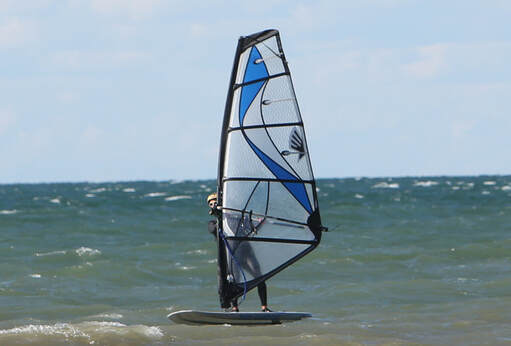
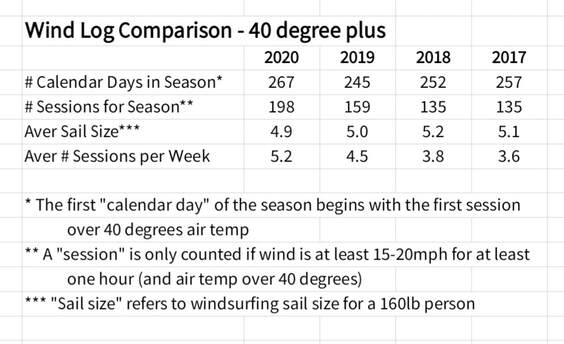
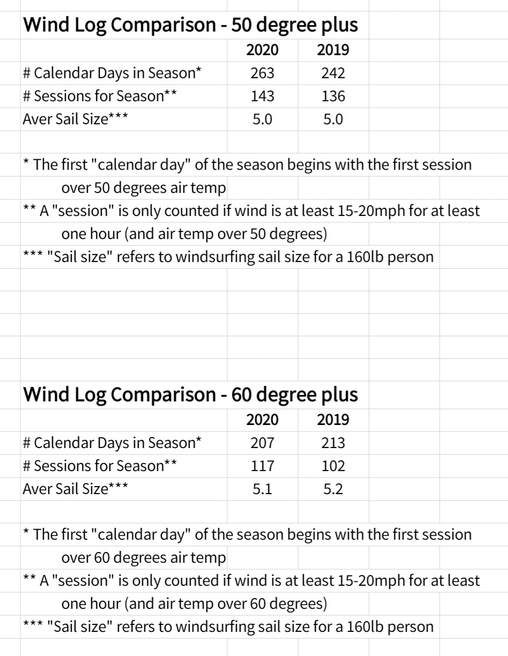
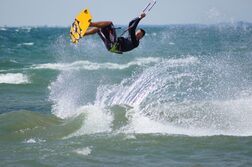
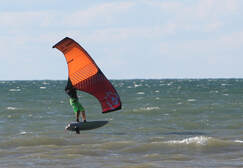
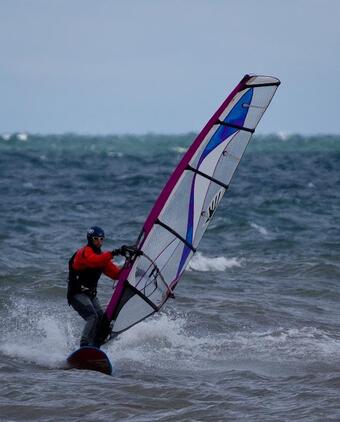
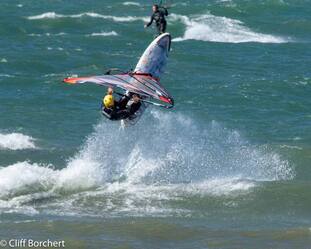
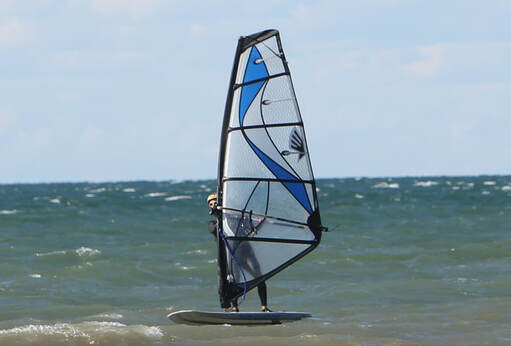
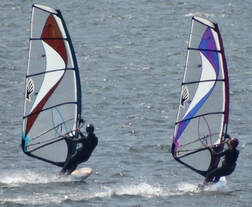
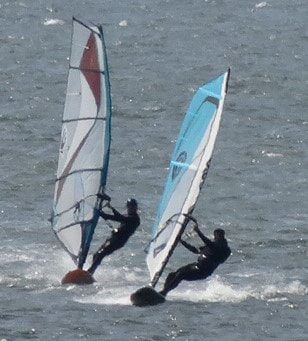
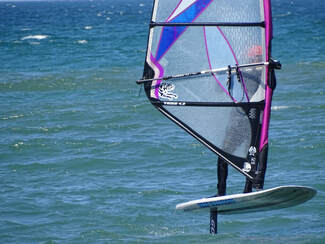
 RSS Feed
RSS Feed
